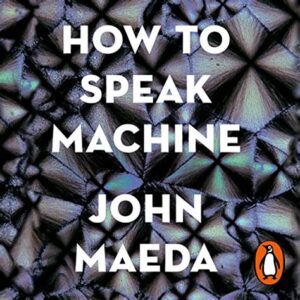
John Maeda, VP of Design and Artificial Intelligence at Microsoft, takes us on a journey through the intricate world of artificial intelligence (AI) in his book “How to Speak Machine.” With his extensive background in art, design, technology, and business, Maeda provides a comprehensive and accessible exploration of AI, its impact on our lives, and the critical role of user research in shaping its future.
The Soft Machines Unveiled: In the book’s first half, Maeda introduces the concept of “soft machines”—powerful, invisible, interconnected entities shaping our digital environment. These soft machines, driven by AI, continuously process vast amounts of data, producing experiences that seamlessly integrate into our daily lives. Maeda explains fundamental computing concepts such as processing loops, recursion, and neural networks, making them accessible to non-computer professionals.
Connecting the Dots: Maeda introduces us to the iconic short film “Powers of Ten” by Ray and Charles Eames. Though this movie was made a half century ago it draws thought-provoking parallels between the world we live in and artificial intelligence. In the opening scene, there’s a shot of a couple having a picnic in a Chicago park. The movie then zooms out by powers of 10, showing the city, the earth, before finally coming to a full stop at the outer universe 100 million light years away at 10 24. It then zooms back to earth in powers of 10 to the couple on the blanket, into the skin of the man’s hand, to his DNA, all the way into a carbon nucleus within a molecule of his skin at 10 -13. The film underscores the recursive, infinite, and trackable nature of physical reality which today can potentially be analyzed with AI.
Human vs. Artificial Intelligence: Delving into the second half of the book, Maeda explores the nuanced differences between human and artificial intelligence. Drawing an analogy with French bread, he emphasizes the need for developing an intuition to distinguish between human and machine-generated information. He compares French “au levain” bread, which is made with naturally occurring yeast, to “la levure” bread, which is made with synthetic yeast. While these two types of bread look identical, the French can immediately tell the difference between them by how they taste. While AI excels at tracking and pattern recognition, it falls short in capturing the richness of the human experience.
The Role of User Research: While machine-generated insights tell you what people have done and their patterns, the data being generated can’t tell you what is going on inside the person’s head, their goals, emotions, understanding, context, values, decision making, imagination, culture (the things that make us human that can’t be reduced to a model). However, product developers need this kind of understanding of the end user when developing products that use machine-generated intelligence. He advocates for merging qualitative user research with AI-generated insights, asserting that this combination fosters a deeper understanding of how people react to synthetic experiences and data. For me, this insight offers a valuable perspective on where user experience might fit into an AI-driven world.
Striking a Balance: Maeda neither glorifies nor dooms AI; instead, he envisions a transformative yet challenging future. The book made me reflect on the role of AI in serving human interests and the need for a collective understanding of this rapidly evolving technology so that we guide its development. With an emphasis on “speaking machine,” Maeda encourages readers to gain the knowledge needed to navigate the evolving landscape of AI.
Though it was published in 2019, before the arrival of ChatGPT , “How to Speak Machine” remains relevant and insightful in today’s world. Though a bit windy and repetitive at times, his book stands out as one of the most interesting and useful non-fiction books I’ve read in a while offering an accessible perspective on the relationship among AI, user research, and the evolving human experience in a technology-driven world.
Book Details: Title: How to Speak Machine: Computational Thinking for the Rest of Us Author: John Maeda Publisher: Portfolio Year: 2019
I interviewed John a few years ago for the QRCA VIEWS Magazine Here’s a link to the article.